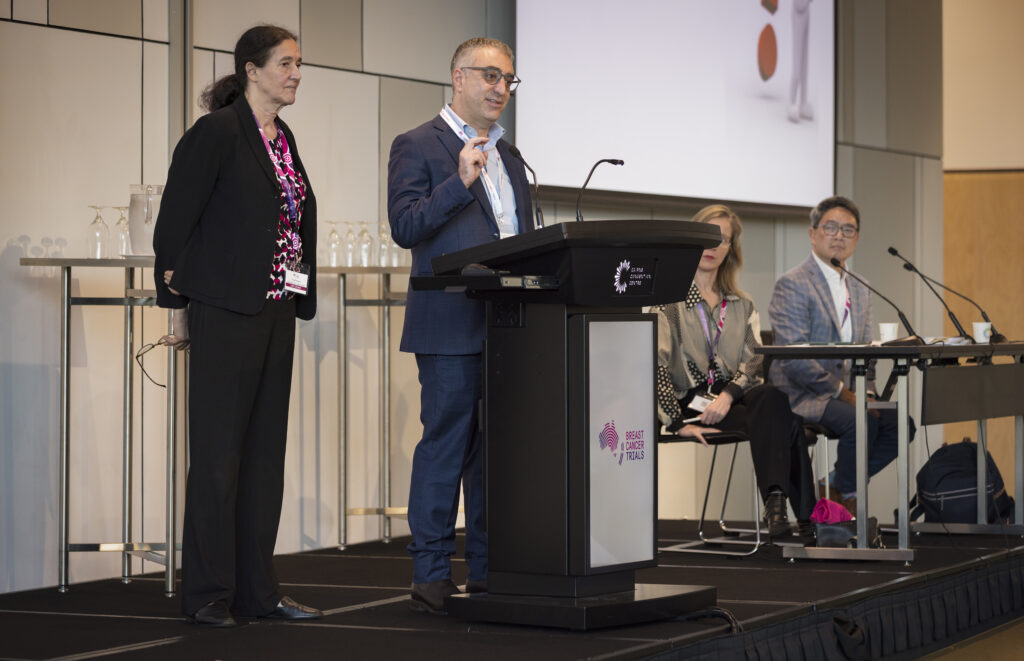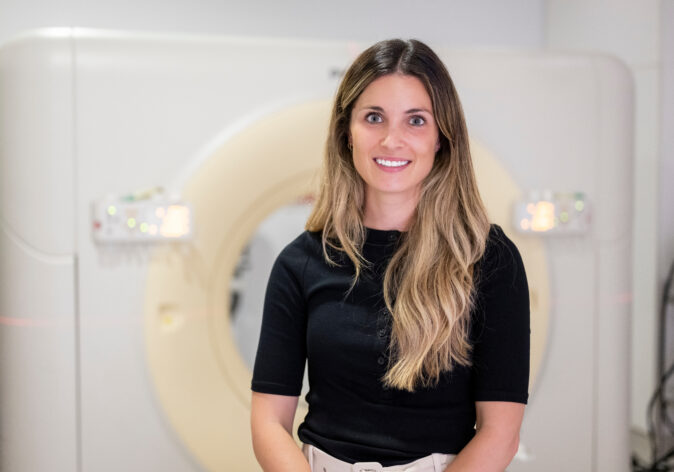Professor Prue Francis is the Clinical Head of Breast Medical Oncology at the Peter MacCallum Cancer Centre and a Consultant Medical Oncologist at St Vincent’s Hospital in Melbourne. She Chaired the International Steering Committee responsible for the SOFT and TEXT clinical trials, that have led to practice changes practice in the management of young women with hormone receptor positive early breast cancer.
Associate Professor Steven David is an experienced Radiation Oncologist at the Peter MacCallum Cancer Centre, bringing a strong interest in implementing cutting edge radiation technology to provide his patients with the highest level of care.
We spoke to Prue and Steven about oligometastatic breast cancer from the perspectives of a Medical Oncologist and a Radiation Oncologist, and the current standard treatment approaches for this disease.
Oligometastatic breast cancer is a term used to describe a specific situation in breast cancer. When breast cancer spreads beyond the original tumor, it’s called metastasis. Most metastatic breast cancer involves multiple spread-out tumors in various places.
However, in oligometastatic breast cancer, the cancer has spread but only to a limited number of places—typically, just a few distant spots like the bones, liver, or lungs. It’s different from more widespread metastasis because the cancer is not as scattered or extensive.
In simpler terms, if you think of metastatic breast cancer as a large network of many new tumor spots, oligometastatic breast cancer is like having just a few new spots. This smaller number of metastases can sometimes make it easier to treat and manage, often with a combination of local treatments (like surgery or radiation) and systemic treatments (like hormone therapy or chemotherapy).
The goal with oligometastatic breast cancer is often to control or reduce the spread and potentially extend the time before the cancer progresses further.
“So, traditionally we think of breast cancer as either being an early stage breast cancer, where the cancer is confined to the breast or the breast and the regional or the nearby lymph nodes, and then we talk about metastatic breast cancer where actually there is a spread of the breast cancer to a place that is distant from the breast and the nearby lymph nodes, for example the bone, the lung or the liver,” Prue said.
“Now, oligometastatic breast cancer has some similarities to metastatic breast cancer in that there are metastases that are distant from the breast and the nearby lymph nodes, but there is a limited number of metastases, so typically with oligometastatic breast cancer there’s a maximum of up to five metastases, so it’s a small number of metastases.”
What are some of the current standard treatment approaches for oligometastatic breast cancer?
“Well, typically, oligometastatic breast cancer would be treated more like metastatic breast cancer, and if there are a very limited number of distant metastases, for example, some patients might have only one distant metastasis, the question that arises is: could that patient actually be treated perhaps more like early breast cancer, but with some additional technique to try and eradicate that problem site, that single site of distant metastasis?”
“And so that’s why we try to think more carefully about this situation. We lack evidence for that sort of approach, but this is something that we think about, and we want to study,” she said.
Listen to the Podcast
We spoke to Prue and Steven about oligometastatic breast cancer from the perspectives of a Medical Oncologist and a Radiation Oncologist, and the current standard treatment approaches for this disease.
What are some of the primary goals of radiation therapy when treating oligometastatic breast cancer?
“So, radiation therapy in the last 10 years has developed a new technique or a new modality of delivering radiation and it’s due to technology, and that technique or technology is called stereotactic radiation,” said Steven.
“It can be delivered to any part of the body and it’s different from any other type of radiation in that it can be delivered like a laser beam, very accurately, very quickly, and with almost none or very few side effects to anything around where you’re aiming it at.”
“And so immediately what people have thought about in oligometastatic breast cancer is why don’t we use that technique to eliminate the oligometastases or destroy them? We can do that very quickly in maybe 10 or 15 minutes with one or two treatments, with excellent long-term outcomes in terms of killing off the cancer in that spine,” he said.
“The question arises, is that a good idea? It’s certainly very attractive to patients, you know, if I’ve got a spot in the bone can you just get rid of it in 10 minutes? Well it sounds very attractive, but is it a good idea? And that’s where a lot of the research at the moment is centered around whether that is a good idea or not.”
How do you determine if a patient with breast cancer is suitable for radiation therapy?
“So, in the oligometastatic setting as technology has gotten better, we can distribute it more broadly, and in more situations. But there are some scenarios where you can’t do it. For example, if a metastasis is right near something that is very critical such as the spinal cord, it’s almost impossible to kill that deposit without also killing the spinal cord, and then it would be disastrous for a patient,” he said.
“So, location, number of metastases, size of metastases, and also if the patient’s had previous radiation, let’s say for a breast cancer, and then an oligometastases is nearby, it makes it very challenging because you’re overlapping with treatment you’ve given in the past. And so those are the sorts of factors we look at and think about.”
“When we decide if someone’s safe for oligometastatic treatment. One of the earlier studies that was done in oligometastatic breast cancer was looking at patients with a few different types of malignancies. There was lung cancer, there might have been prostate cancer, breast cancer, different types of malignancies, but all with a small number of metastatic sites.”
“And this trial was trying to look at if those patients had their disease otherwise controlled by a drug therapy that they’d started on, if they could try to deliver a dose of either radiation or perhaps surgery to a site, could you actually give them a better outcome by eradicating those local tumours, and just focusing on those distant metastases?”
“And that trial suggested that there was a survival advantage. It was not a very large trial, but it suggested that there was a survival advantage. But the number of breast cancer patients in the trial was relatively small. It wasn’t only a trial looking at breast cancer.”
“Then more recently, there’s been a trial that was trying to address this question again, but in a specific breast cancer population. And again, thinking about whether trying to eradicate those small number of sites of distant metastases could lead to a better outcome in terms of survival. And, in fact, that follow up trial actually did not show a benefit in overall survival.”
“So, I think we’re in a situation where we know we can deliver local radiation to these sites and potentially get some control of those sites, but whether that actually ultimately impacts the patient’s overall journey with metastatic breast cancer and their survival has not actually been clearly shown in breast cancer.”
“So, we really need more information to say that we should be doing this, really to routinely offer this. So, it remains really something that needs to be proven for breast cancer.”
In what ways does personalised medicine play a role in treating oligometastatic breast cancer?
“It’s a good question and I think I can answer it with starting with examples of two different sorts of patients. So, for example, there might be a patient who had breast cancer 15 years ago and had it treated successfully. And then 15 years later, they develop one bone metastasis. That patient has oligometastatic disease. A similar patient, in my case, has oligometastatic disease, and turns up with three bone metastases on the same day that they’re diagnosed with their primary, and that’s part one,” said Steven.
“And part two is, there are patients with different subtypes of breast cancer. We talked about HER2-positive, there’s triple negative, and there’s other types. So, these trials generally group all those patients together and call them all oligometastatic patients, and we now know that there’s different types of oligometastatic disease, and so I think whenever you start research you group everyone together and try and find a bit of an answer to a global question because it’s very hard to recruit very narrow groups of patients.”
“But I think where we’re heading now is really looking at subtype specific patients and researching them differently because we do believe that it’s possible there might be very different answers for those different patients. So that’s the subject of ongoing research and investigation,” he said.
“I guess there’s one type of patient group with very limited metastatic disease that probably people would agree requires a standard of care to try to eradicate that disease and that’s with a central nervous system metastasis (CNS), where it would be considered a standard of care to try to either surgically and or radiate that limited metastatic burden. That would be considered a standard of care.”
What are your hopes for the future?
“Well, in the oligometastatic setting the attractive thing is that it has never been thought that you could cure metastatic disease, and really that’s something across all of cancer. So, it’s a bit of a prior golden egg, a prize really, patients would love it and doctors obviously would love it if we could cure stage four disease,” said Steven.
“And I’ve seen Prue give a talk on that topic, on HER2-positive breast cancers, and she thinks they will be cured sometime soon. And perhaps radiation stereotactic to small deposits may be part of that story. And I think that would be a fantastic thing to talk about and to be able to say to patients, we’re going to cure you, even though it’s spread beyond the breast. And there’s every chance that’ll be in our lifetime, I think,” he said.
“I think in the area of oligometastatic disease, we have a few new tools in our kit bag from a drug therapy point of view that haven’t previously been tested formally in patients with oligometastatic disease. They’re things that we now would use in a higher risk, early-stage breast cancer patients,” said Prue.
“For example, a PARP inhibitor in a patient with a BRCA mutation or a CDK4/6 inhibitor in a patient with ER-positive HER2-negative high-risk disease, or perhaps immunotherapy in a high-risk triple negative breast cancer patient.”
“So, the question is, if we were to apply these types of therapies in the context of the overall treatment paradigm for a patient with an oligometastatic disease with those specific features, could that translate into any difference in a patient with a very limited number of metastases? Could that translate into any cures? Because at this stage we don’t have good information on how that would work with those newer therapies,” she said.
Our life-saving breast cancer research is only possible thanks to the continued generosity of our supporters. Please help continue this vital work by making a donation today.
Support Us
Help us to change lives through breast cancer clinical trials research



